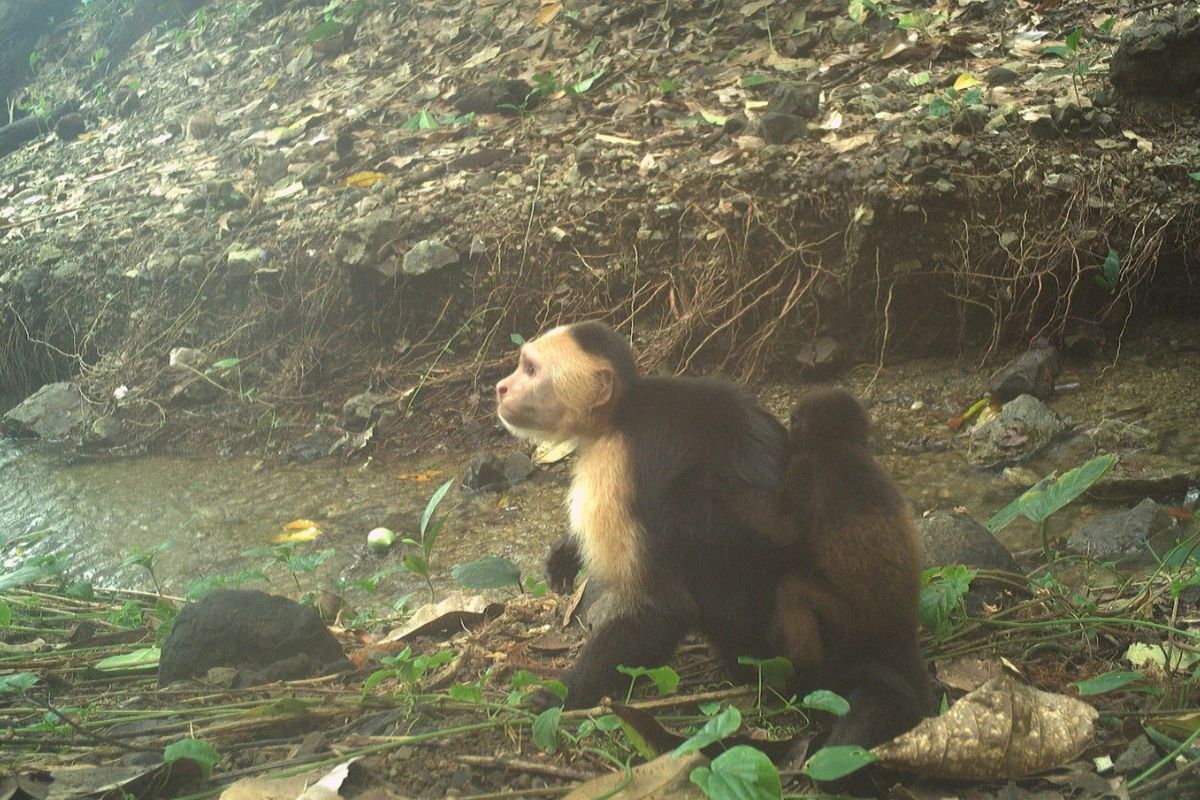Show table of content Hide table of content
In the lush forests of Jicaron Island, off the coast of Panama, a bizarre phenomenon has captured the attention of primatologists worldwide. Young male capuchin monkeys have developed a strange tradition: they kidnap baby howler monkeys from their mothers. This unprecedented behavior, documented by researchers in May 2025, represents the first recorded instance of one species systematically abducting the offspring of another without apparent predatory intent.
Strange kidnapping behavior among capuchin monkeys
The discovery of this unusual primate behavior began in 2022 when behavioral ecologist Zoë Goldsborough was analyzing footage from motion-sensor cameras on Jicaron Island. She was startled to observe a white-faced capuchin carrying a baby howler monkey on its back. This capuchin, nicknamed “Joker” for a mouth scar reminiscent of Batman’s nemesis, was subsequently identified kidnapping four different howler infants.
Initially, researchers believed this might be an isolated case of cross-species adoption. However, the behavior spread among the island’s capuchin population. Within fifteen months, scientists documented five capuchin monkeys carrying eleven baby howlers. The cameras also captured distressing footage of adult howler monkeys desperately searching and calling for their missing infants.
What makes this behavior particularly puzzling is that the capuchins don’t consume the infants or even appear to play with them. Instead, they simply carry the babies for days, during which time the infants often perish from dehydration or starvation, unable to nurse from their mothers. This kind of social transmission of behavior echoes how orphaned animals sometimes require specialized care, though in this case, the intentions are far from nurturing.
How capuchins execute their infant abductions
The mechanics of these kidnappings remain somewhat mysterious to researchers. Since the monitoring cameras are positioned on the ground while the primates spend most of their time in the canopy of Coiba National Park, the actual abductions haven’t been captured on film. Scientists are impressed by the capuchins’ apparent skill in separating very young infants from their mothers without visible injuries.
What makes this feat even more remarkable is the significant size disparity between the species. Adult howler monkeys are approximately three times larger than capuchins, yet the smaller primates successfully snatch newborns as young as one or two days old. This unexpected predatory behavior mirrors the shocking nature of newly discovered predators in other ecosystems.
By July 2023, when the initial study concluded, researchers had documented at least one additional kidnapping. However, the frequency appears to be declining, potentially due to the decreasing population of howler monkeys on the island. Howlers are classified as an endangered species, making this predatory behavior potentially concerning for conservation efforts.
Animals A female sea lion refuses to mate with a male, causing a fight and the closure of the zoo.
Social traditions in the animal kingdom
The capuchins’ kidnapping behavior represents what researchers believe is a social tradition or “fad” among the young males of Jicaron Island. This isn’t the first time scientists have observed the transmission of seemingly arbitrary behaviors among animal populations. Co-author Brendan Barrett previously studied capuchins in Costa Rica that began grooming porcupines, a trend that eventually faded.
Marine mammals have exhibited similar social traditions. In the 1980s, orcas along the American Northwest coast developed a habit of balancing dead salmon on their heads, a behavior that researchers dubbed “salmon hats.” Interestingly, this practice disappeared for decades before resurfacing last year. These behaviors demonstrate how animal cultures can develop and transmit practices similar to how maternal behaviors evolve in marine mammals.
Researchers originally came to study Jicaron’s capuchins in 2017 because of their tool use—specifically, their ability to use stones to crack open nuts and shellfish. This demonstrated intelligence, combined with abundant food resources and absence of predators, gives these primates substantial leisure time. Barrett describes them as “exploratory agents of chaos,” suggesting their surplus time may facilitate the development and transmission of both useful behaviors (like tool use) and seemingly arbitrary ones (like infant kidnapping).
The science behind primate behavioral innovations
The study of these kidnapping behaviors was published in Current Biology in May 2025, with Goldsborough as lead author. The research team suggests this represents the first documented case of one species repeatedly kidnapping the young of another species. The consequences have been fatal for at least four baby howler monkeys, with researchers suspecting similar outcomes for other abducted infants.
Animals A hammerhead shark crashes down from the sky in South Carolina, halting a disc golf game.
This research provides valuable insights into behavioral evolution and social learning among primates. In environments where basic survival needs are easily met, primates may develop complex social behaviors that aren’t directly tied to survival advantages. This parallels how technological innovations allow humans to develop cultural practices beyond basic survival.
Some scientists speculate that studying unusual behaviors like these could enhance our understanding of behavioral adaptability across species. Recent advances in animal observation technology, similar to robotic systems used to study marine creatures, have enabled researchers to document previously unknown animal behaviors.
The documentation of rare primate behaviors continues to expand our knowledge of animal cognition. From tool use to complex social traditions, primates demonstrate remarkable behavioral plasticity. In some cases, these observations lead to surprising discoveries, much like when iconic animals inspire cultural touchstones or when rare species are documented for the first time.
The capuchin kidnapping tradition joins other documented cases of unusual animal behaviors, like the specialized feeding strategies of cave-dwelling crocodiles. These studies collectively enhance our understanding of behavioral evolution and the complex social lives of animals, reminding us that the natural world continues to surprise even seasoned researchers.
Animals A wild elephant enters a convenience store and raids the food aisle.


